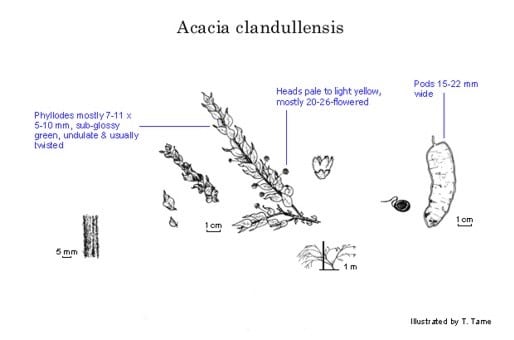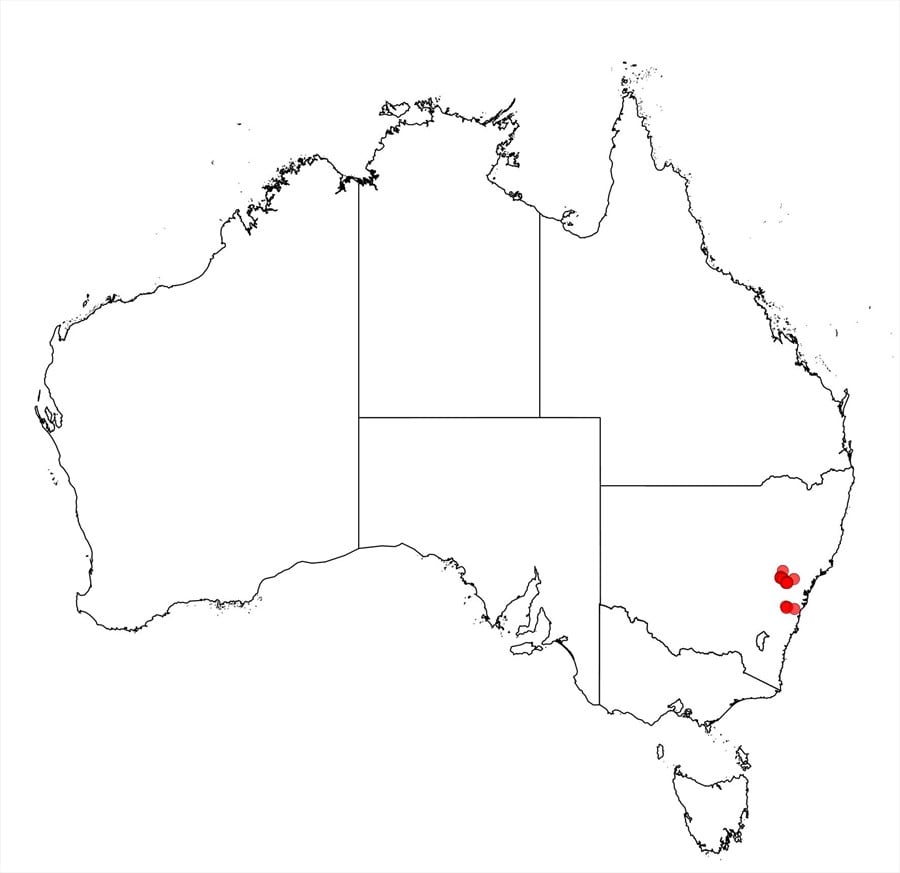Acacia clandullensis B.J.Conn & Tame
WATTLE
Acacias of Australia
Family
Fabaceae
Distribution
Mostly confined to the Clandulla and Glen Davis areas of N.S.W., with a localised population near Yerranderie.
Description
Open pendulous shrub to 1 (–2) m high; stem unbranched at base or with few primary downwards arching branches. Branchlets slightly ribbed, becoming terete, green to brown, smooth, densely hairy. Phyllodes somewhat crowded; base of lamina coplanar with branchlets, with lamina towards apex twisted and/or sometimes bent, asymmetric, orbicular to broadly elliptic to obovate, (4–) 7–11 (–16) mm long, (3–) 5–10 (–11) mm wide, l:w = 1.2–1.4 (–1.6), subglossy, light green; base oblique and asymmetric and usually acute; margin thickened, markedly undulate and with scattered hairs; apex oblique, acute-acuminate to acute or obtuse mucronate; gland inserted to 1 mm above pulvinus, small, with inconspicuous rim. Inflorescences with peduncles (5–) 8–9 (–11) mm long, about as long as floral phyllodes, moderately hairy; heads 4–5 mm diam., 20–26 (–30)-flowered, pale yellow to light yellow, sometimes to bright yellow. Corolla lobes usually with few long hairs. Pods oblong, flat, straight or slightly curved, 60–75 mm long, 15–22 mm wide, firmly coriaceous, dull, dark brown; margin prominent, barely constricted between seeds, slightly undulate.
Habitat
Occurs mostly on stony sandy or loamy clay soils, frequently in Eucalyptus rossii woodlands, at higher altitudes.
Specimens
N.S.W.: Tonalli Rd between Tonalli R. and Byrnes Ck, 2 miles W of Lake Burragorang, Mitchell 412 (NSW); 4.3 km S of Clandulla, T.M.Tame 3995 (NSW); 0.9 km N of Clandulla, T.M.Tame 4107 (NSW).
Notes
The branchlet hairs are short and subappressed with longer patent hairs, 0.2–0.8 mm long, grey to whitish. Inflorescence hairs are similar to branchlet hairs. The young phyllodes have a few scattered long hairs on the lamina, becoming distally glabrous.
This species has some similarity to A. sertiformis but differs in its lower diffuse habit, very small twisted bright green phyllodes and fewer pale yellow flowers per head. It is also distinguished by the appressed to subappressed hairs on the branchlets, pulvini and peduncles and the closely appressed appearance of the young phyllodes against the branchlet. The glossy appearance of the phyllodes appears to be owing to the lack of a fibrous-like cuticular ‘wax’ which is present on the phyllodes of all other members of the group. It is a distinctive taxon in the field with its small lemon-yellow flowers, open, downwards arching branches and the often very small phyllodes appearing to be appressed to the branchlets.
FOA Reference
Data derived from Flora of Australia Volumes 11A (2001), 11B (2001) and 12 (1998), products of ABRS, ©Commonwealth of Australia
Author
B.J.Conn, T.M.Tame
Minor edits by B.R.Maslin
This identification key and fact sheets are available as a mobile application:
URL: https://apps.lucidcentral.org/wattle/
© Copyright 2018. All rights reserved.







